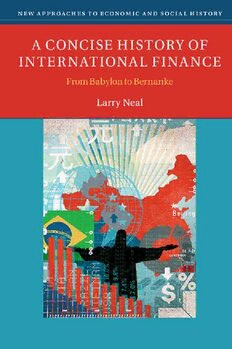
A Concise History Of International Finance: From Babylon To Bernanke PDF
Preview A Concise History Of International Finance: From Babylon To Bernanke
| A Concise History of International Finance Ever since the financial crisis of 2008, doubts have been raised about the future of capitalism. In this broadranging survey of financial capitalism from antiquity to the present, Larry Neal reveals the ways in which the financial innovations throughout history have increased trade and prosperity as well as improving standards of living. These innovations have, however, all too often led to financial crises as a result of the failure of effective coordination among banks, capital markets, and governments. The book examines this key interrelationship between financial innovation, government regulation, and financial crises across 3,000 years, showing through past successes and failures the key factors that underpin any successful recovery and sustain economic growth. The result is both an essential introduction to financial capitalism and also a series of workable solutions that will help both to preserve the gains we havealreadyachievedandtomitigatethedangersoffuturecrises. larry neal is Emeritus Professor of Economics at the University of IllinoisatUrbana-Champaign,ResearchAssociateoftheNationalBureau of Economic Research, and Visiting Professor at the London School of Economics (2006–2014). Specializing in financial history and European economies,heisauthorofTheRiseofFinancialCapitalism:International CapitalMarketsintheAgeofReason(CambridgeUniversityPress,1990). HisrecentpublicationsincludeeditingTheCambridgeHistoryofCapital- ism(CambridgeUniversityPress,2014);and“Iamnotmasterofevents”: The Speculations of John Law and Lord Londonderry in the Mississippi andSouthSeaBubbles(2012). newapproachestoeconomicandsocialhistory series editors BarryDoyle(UniversityofHuddersfield) DebinMa(LondonSchoolofEconomicsandPoliticalScience) LarryNeal(UniversityofIllinois,Urbana-Champaign) NewApproachestoEconomicandSocialHistoryisanimportantnewtextbook series publishedinassociationwiththeEconomic History Society.It provides concisebutauthoritativesurveysofmajorthemesandissuesinworldeconomic andsocialhistoryfromthepost-Romanrecoverytothepresentday.Booksin the series are by recognized authorities operating at the cutting edge of their field with an ability to write clearly and succinctly. The series consists princi- pally of single-author works – academically rigorous and groundbreaking – which offer comprehensive, analytical guides at a length and level accessible toadvancedschoolstudentsandundergraduatehistoriansandeconomists. A Concise History of International Finance From Babylon to Bernanke larry neal UniversityofIllinoisatUrbana-Champaign UniversityPrintingHouse,CambridgeCB28BS,UnitedKingdom CambridgeUniversityPressispartoftheUniversityofCambridge. ItfurtherstheUniversity’smissionbydisseminatingknowledgeinthepursuitof education,learningandresearchatthehighestinternationallevelsofexcellence. www.cambridge.org Informationonthistitle:www.cambridge.org/9781107034174 ©LarryNeal2015 Thispublicationisincopyright.Subjecttostatutoryexception andtotheprovisionsofrelevantcollectivelicensingagreements, noreproductionofanypartmaytakeplacewithoutthewritten permissionofCambridgeUniversityPress. Firstpublished2015 PrintedintheUnitedKingdombyTJInternationalLtd.PadstowCornwall AcataloguerecordforthispublicationisavailablefromtheBritishLibrary ISBN978-1-107-03417-4Hardback ISBN978-1-107-62121-3Paperback CambridgeUniversityPresshasnoresponsibilityforthepersistenceoraccuracy ofURLsforexternalorthird-partyinternetwebsitesreferredtointhispublication, anddoesnotguaranteethatanycontentonsuchwebsitesis,orwillremain, accurateorappropriate. Contents List of figures pagevii List of boxes x List of tables xi Preface xiii 1 Introduction 1 2 Distant beginnings: the first 3,000 years 15 3 The Italians invent modern finance 28 4 The rise ofinternational financial capitalism: the seventeenth century 52 5 The “BigBang” of financial capitalism: financing and re-financing the Mississippi andSouth SeaCompanies, 1688–1720 72 6 The rise and spread offinancial capitalism, 1720–1789 100 7 Financialinnovations duringthe “birth ofthemodern,” 1789–1830: a tale of three revolutions 134 8 British recovery and attemptsto imitate intheUS, France, and Germany,1825–1850 166 9 Financialglobalization takes off: thespreadof sterling and the rise of the goldstandard, 1848–1879 190 10 The first globalfinancial market and theclassical goldstandard, 1880–1914 210 11 The Thirty Years War and the disruption of international finance, 1914–1944 231 v vi Contents 12 The Bretton Woodsera and the re-emergence ofglobalfinance, 1945–1973 253 13 Fromturmoil tothe “Great Moderation,” 1973–2007 272 14 The sub-prime crisis andtheaftermath, 2007–2014 294 References 313 Index 336 Figures 3.1 The bill ofexchange asan instrument to finance trade page30 3.2 The bill ofexchange asa credit instrument 34 3.3 Sovereign bond yields inwestern Europe, 1290–1780 50 4.1 Share prices for VOC, 1602–1698 61 5.1 The Mississippibubble, 1719–1720 (livres tournois per share) 92 5.2 The French exchangerate, 1719–1720 (pence/écu, 2 months’ usance) 93 5.3 The SouthSeabubble,1720 (percent ofparforshares inSouthSeaCompany,EastIndiaCompany,andBank of England) 96 6.1 The payments network of western Europe, c.1720 106 6.2 Short-term commercial interest rates, 1723–1789 (five-year moving averages of annualpercentages) 108 6.3 Britishnational debt, 1694–1815 (million pounds sterling, current) 110 6.4a Prices of the British“funds,”1721–1763 112 6.4b Prices ofthe British“funds,” 1764–1809 112 6.5 Britishwar finance via bills of exchange 114 6.6 Acceptance bills from Amsterdam, through Hamburg to Berlin 116 6.7 London exchange rates on Amsterdam, 1723–1810 117 6.8 The 1763 crisisinexchange rates (Amsterdam and Hamburg, schellingen banco/pound sterling; Paris, pence/écu = 3 livres tournois) 123 6.9 Weekly total bankerbalances at Bank of Amsterdam, 1763, showing accumulation by channel 124 7.1 Exchange rates against theBritish pound, 1789–1825 145 7.2 Yields on long-term sovereign bonds,France (rente) and Britain (Consol),1798–1825 146 7.3 Yields on “The Funds” of Britain,” 1819–1837 147 vii viii Listpffigures 7.4 Latin American bond yields,and French rentes, 1822–1827 154 7.5 Stock Index for the London Stock Exchange, 1811–1830 159 8.1 Microstructureof the London Stock Exchange, 1812–1876 172 8.2 Government bond yields,industrial core nations, 1825–1913 188 9.1 Ouncesofsilvertobuyoneounceofgold,USmarket, 1687–1912 193 9.2 The railway network of Europe,1880 200 10.1 Yields on sovereign bonds,major European countries,1880–1914 211 10.2 Wholesale price indices for industrial corecountries duringthe gold standard, 1820–1910 212 10.3 Gold reservesof the major European public banks, 1880–1914 (millionFrench francs) 215 11.1 Inter-Allied war debts, 1919 (million dollars) 239 11.2 Gold reservesof the leadingpowers, 1924–1935 243 11.3 ThecourseofGDPforthemajorpowers,1919–1939 245 11.4 Real GDPs oftheGreatPowers, 1938–1945 (billion dollars at1990 prices) 251 12.1 The dollar shortage, 1945–1950 259 12.2 The US runsout of gold 264 12.3 The rise of international bond issues during capital controls, 1963–1971 268 12.4 InternationalreservesofthemajorEuropeanpowers, 1948–1973 (millionSDRs) 269 13.1 The uncertainty ofexchange rates,1970–2005 (selected G-10 countriesagainst theUS dollar, 1960) 274 13.2 The price of goldin US dollars,1970–2005 (average per Troy ounce) 275 13.3 Leading up to theeuro,European exchangerates against the US dollar,1960–2004 286 13.4 Yields on governmentdebtfor euro-zonecountries, 1960–2004 287 14.1 US sovereigndebt, 1993–2014 (million US dollars) 298 14.2 Total mortgage debtin the US, 1993–2014 (million US dollars) 299 Listoffigures ix 14.3 How toxic assets were created 300 14.4 How RMBS assets used forcollateral became toxic 301 14.5 Sovereign bond yields intheeuro-zone, 1993–2014 308 14.6 Ten-year sovereign bond yields for Greece, Ireland, Portugal, and Spain compared to Germany,January 2008–January 2012 309 14.7 Totalmarketable sovereign debt ineuros, aspercent of GDP,2000–2014 310
